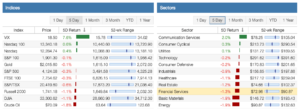Economic Report: U.S. retail sales jump 1.7%, but high inflation plays role

The numbers: Sales at U.S. retailers such as WalMart
WMT,
and Amazon
AMZN,
rose in October at the fastest pace in seven months in another good showing for the economy, but high inflation also exaggerated the amount of spending.
Retail sales surged 1.7% last month, the government said Tuesday. That’s the biggest gain since March when the government doled out billions of dollars in stimulus money to families.
Economists polled by The Wall Street Journal had forecast a 1.5% increase.
Retail sales are a big part of consumer spending and offer cues on the strength of the U.S. economy. Sales have risen sharply this year and retailers are expecting a solid end to the year even with the pandemic lingering.
Yet as much as half of the increase in retail sales last month was tied to higher prices. A separate government survey last week showed that consumer prices rose almost 1% in October amid the biggest surge in U.S. inflation in 31 years.
Big picture: Most Americans saved money during the pandemic and they have plenty to spend. That’s the good news for a U.S. economy that relies heavily on consumer spending to fuel growth.
Read: Mystery of missing millions the only blemish on a strong U.S. jobs report
The bad news? Americans are paying more for almost everything. And some products such as new cars are harder to find.
Read: High inflation is eating up the budgets of American households
High prices and ongoing shortages are expected to persist into 2022 and could mar what was shaping up to be the strongest holiday shopping season in years.
Key details: Sales rose 4% last month at internet retailers, 3.8% at electronics and appliance stores and 2.2% at department stores to lead the way in October.
These increases show Americans still have plenty of appetite for most consumer goods even though they are paying higher prices.
Sales also climbed 1.8% at auto dealers, but partly because of record prices. Automakers can’t make enough cars to satisfy demand due to a global parts shortage. Auto sales account for about one-fifth of overall retail spending.
Gas prices also surged 3.9% last month because of higher oil prices.
If autos and gas are set aside, U.S. retail sales rose a smaller 1.4% last month. Those two categories often exaggerate ups and downs in consumer spending and aren’t always good indicators of how much households are willing to spend.
The only retailers to experience a decline in sales last month were clothing outlets and health and personal-care stores such as pharmacies and beauty salons.
The retail figures are seasonally adjusted.
What they are saying? “Should inflation continue to climb, it will pose a larger challenge to families on tight budgets,” said senior economist Sal Guatieri of BMO Capital Markets. “But for now, both consumers and the economy look to cap the year on a high note.”
Market reaction: The Dow Jones Industrial Average
DJIA,
and S&P 500
SPX,
were set to open higher in Tuesday trades. Stocks have been hitting record highs in the past few weeks.
Published at Tue, 16 Nov 2021 08:18:00 -0800




